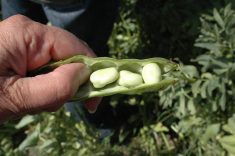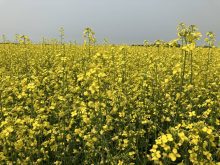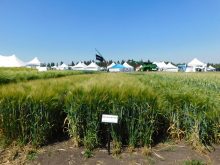Beets At the end of the September growers were still waiting for it be cool enough to pile
As with most others in the province, many southern Alberta farmers had the first harvest they can remember with no weather interruption, or even pressure to finish harvest before a rain shower. Some have run short of storage space, while others saw good early prospects dim after heat and dryness in July and August.
Winter wheat was the star of 2012 — the wet spring that delayed seeding of spring crops was perfectly timed for winter wheat. Some growers report yields over 100 bushels under irrigation and dryland yields seem to have averaged between 50 and 60 bushels. More is expected next year — some seed growers sold out early.
Read Also

New crop insurer policy enables easier startup for faba beans
Agriculture Financial Services Corporation updated its normals for faba beans, which may open the door for more Canadian producers to feel comfortable growing the pulse crop in the future.
Peas also took advantage of early moisture and the very earliest-seeded peas were the best crops in dry areas where there hasn’t been even a shower since June 23. Winter peas and winter lentils in trials at Lethbridge were spectacular.
Specialized irrigation crops all seem to have done well — irrigators are set up for hot dry weather and they took full advantage of ideal conditions. Bean growers have had an excellent year with average yields estimated at about 100 pounds more than the long-term average of 2,300 pounds.
“We thought we’d get even higher yields,” said Larry Doherty, a field rep for Viterra, based in Bow Island. “Maybe we held off the water a little too much. But, we had very little white mould (sclerotinia), so maybe we got it right.”
Mostly, the quality is excellent, but many crops are too dry — splits are higher then normal.
Sugar beet growers can’t start harvest until it’s cool enough to pile the beets safely, and during the last week of September only one day didn’t have afternoon temperatures over 25 C.
Insects
Wheat midge damaged some spring wheat in southern Alberta this season, and Alberta Agriculture pest specialist Scott Meers advises all farmers in south-central Alberta to scout their wheat for midge from heading until flowering.
“Once you have wheat midge in a field, you need to scout it and neighbouring fields for it every year,” he sid. “Low areas and wet spots act as a reservoir for wheat midge, but also for the natural enemies that keep it in check.”
Meers’s surveys indicates pea leaf weevil and cabbage seedpod weevil both stayed pretty much in their traditional area south of Highway 1 this year.
A major flight of diamondback moths arrived in Alberta early, but for some reason the population didn’t grow significantly.
“Something took them out,” says Meers. “We’re not sure what. It has a parasitic wasp that attacks it or a disease may have limited it. We don’t understand the dynamics of those balances.
“The other thing we don’t understand is the outbreak of monarch butterflies we had this year.”














